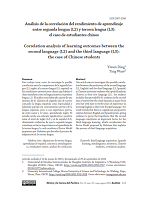Correlation analysis of learning outcomes between the second language (L2) and the third language (L3): the case of Chinese students
DOI:
https://doi.org/10.32870/mycp.v12i35.828Keywords:
third language acquisition, Spanish learning, metalinguistic awareness, Chinese students, correlation analysisAbstract
This article aims to investigate the possible correlation between the proficiency of the second language (L2, English) and the third language (L3, Spanish) in Chinese university students who speak Mandarin Chinese as their first language (L1). The analysis includes data provided by 61 students in the second year of university who study Spanish as major from zero but with nine to twelve years of experience in learning English as their first foreign language. The result reveals that there is a significant and positive relation between English and Spanish levels, giving evidence to prove the hypothesis that the second language constitutes an important factor for the third language learning, which corroborates the Factor Model proposed by Hufeisen that explains the process of third language acquisition.Downloads
References
Bardel, C., & Falk, Y. (2012). The L2 status factor and the declarative/pro- cedural distinction. En J. C. Amaro, S. Flynn & J. Rothman (Eds.), Third Language Acquisition in Adulthood (pp. 61-79). John Benjamins.
Brown, C., Holman, E., Wichmann, S., & Velupillai, V. (2008). Automated Classification of the World’s Languages: A Description of the Method and Preliminary Results. STUF - Language Typology and Universals, 61, 285-308. https://doi.org/10.1524/stuf.2008.0026
Brown, J. I. (2002). Reading Power. Houghton Mifflin Company.
Clément, R. (1986). Second language proficiency and acculturation: an investigation of the effects of language status and individual characteristics. Journal of Language and Social Psychology, 5, 271-290. https://doi.org/10.1177/0261927X8600500403
Clément, R., Dörnyei, Z., Noels, K. (1994). Motivation, self-confidence and group cohesion in the foreign language classroom. Language Learning, 44, 417-448. https://doi.org/10.1111/j.1467-1770.1994.tb01113.x
De Angelis, G. (2007). Third or Additional Language Acquisition. Multilingual Matters.
Eibensteiner, L. (2022). L3 acquisition of aspect: the influence of structural similarity, analytic L2 and general L3 proficiency. International Review of Applied Linguistics in Language Teaching. https://doi.org/10.1515/iral- 2021-0220.
Ellis, R. (2014). The Study of second language acquisition. Shanghai Foreign Language Education Press.
Falk, Y., & Bardel, C. (2010). The study of the role of the background languages in third language acquisition. The state of the art. International Review of Applied Linguistics in Language Teaching, 48(2-3), 185-219. https://doi.org/10.1515/iral.2010.009
Falk, Y., & Bardel, C. (2011). Object pronouns in German L3 syntax: Evidence for the L2 status factor. Second Language Research, 27, 59-82. https://doi.org/10.1177/026765831038664
García-Sanz, E. (2016). La didáctica de terceras lenguas: una introduc- ción orientada a la enseñanza de ELE. MarcoELE. Revista de Didáctica Español Lengua Extranjera, 23, 1-11. https://www.redalyc.org/jatsRepo/921/92153186007/html/index.html
Hammarberg, B. (2001). Roles of L1 and L2 in L3 Production and Acquisition. En J. Cenoz, B. Hufeisen & U. Jessner (Eds.), Cross-Linguistic Influence in Third Language Acquisition: Psycholinguistic Perspectives (pp. 21-24). Multilingual Matters.
Herdina, P., & Jessner, U. (2000). The dynamics of third language acquisition. En J. Cenoz & U. Jessner (Eds.), English in Europe: The Acquisition of a Third Language (pp. 84-98). Multilingual Matters.
Hufeisen, B. H. (2000). A European Perspective: Tertiary Languages with a Focus on German as L3. En J. W. Rosenthal (Ed.), Handbook of Undergra-duate Second Language Education (pp. 209-229). Erlbaum.
Jaensch, C. (2009). L3 enhanced feature sensitivity as a result of higher proficiency in the L2. En Leung Y. I. (Ed.), Third Language Acquisition and Universal Grammar (pp. 115-143). Multilingual Matters.
Jessner, U. (2008). A DST model of multilingualism and the role of metalinguistic awareness. The Modern Language Journal, 92, 270-283. https:// doi.org/10.1111/j.1540-4781.2008.00718.x
Kope?ková, R. (2018). Exploring metalinguistic awareness in L3 phonological acquisition: the case of young instructed learners of Spanish in Germany. Language Awareness, 27(1-2), 153-166. https://doi.org/10.1080/09658
2018.1432629
Lasagabaster, D. (2003). Trilingüismo en la enseñanza. Actitudes hacia la lengua minoritaria, la mayoritaria y la extranjera. Milenio.
Lin, C. C., & Narbona-Pérez, J. E. (2021). La universalidad de la cortesía so- ciolingüística: informes basados en datos cuantitativos de hablantes de inglés, japonés, español y chino. En S. A. Flores Borjabad & R. P. Cabaña (Coords.), Nuevos retos y perspectivas de la investigación en Literatura, Lin- güística y Traducción (pp. 1538-1563). Dykinson.
Lu, J. (2008). Distancia interlingüística: partida de reflexiones metodológicas del español en el contexto chino. México y la Cuenca del Pacífico, 32, 45-56. https://doi.org/10.32870/mycp.v11i32.356
Lu, J. (2020). Cuatro categorías de contraste morfológico entre chino y espa- ñol. Monográficos SinoELE, 20, 177-189.
Marx, N., & Hufeisen, B. (2003). Multilingualism: Theory, Research Methods and Didactics. En G. Bräuer & K. Sanders (Eds.), New Visions in Foreign and Second Language Education (pp. 178-203). LARC Press.
Moghtadi, L., Koosha, M., Lotfi, A. R. (2014). Second Language Grammatical Proficiency and Third Language Acquisition. International Education Studies, 7(11), 19-27. https://doi.org/10.5539/ies.v7n11p19
Paradis, M. (2009). Declarative and Procedural Determinants of Second Languages. John Benjamins.
Rothman, J., González-Alonso, J., & Puig-Mayenco, E. (2019). Third Language Acquisition and Linguistic Transfer. Cambridge University Press.
Sánchez, L. (2014). An Inquiry into the Role of L3 Proficiency on Crosslin- guistic influence in Third Language Acquisition. Odisea, 15, 169-188. https://doi.org/10.25115/odisea.v0i15.282
Sanz, C. (2000). Bilingual education enhances third language acquisition: Evidence from Catalonia. Applied psycholinguistics, 21(1), 23-44. https:// doi.org/10.1017/S0142716400001028
Sternberg, R. J. (2002). Cultural Explorations of Human Intelligence Around the World. Online Readings in Psychology and Culture, 4(3). https://doi.org/10.9707/2307-0919.1035.
Tremblay, M. (2006). Cross-linguistic influence in third language acquisition:The role of L2 proficiency and L2 exposure. Ottawa Papers in Linguistics, 34, 109-111.
Wang, T. (2016). Conocimiento del español y logros laborales de los inmi- grantes en Españas. [Tesis doctoral]. https://ruidera.uclm.es/xmlui/ bitstream/handle/10578/10621/TESIS%20Wang%2C%20Ting.pdf?sequence=1&isAllowed=y
Woll, N. (2016). The role of metalinguistic awareness and of L2 proficiency in positive lexical transfer from English (L2) to German (L3) by French-speaking Quebeckers. [Tesis doctoral].
Xu, J., & Yang, L. (2019). Review of Research on Cross-linguistic Influence in Third Language Acquisition. Journal of Beijing International Studies University, 41(3), 32-11. https://doi.org/10.12002/j.bisu.221
Zhang, T. (2021). El evento de desplazamiento: Análisis contrastivo entre el español y el chino, con referencia al inglés [Tesis doctoral, UAM]. Biblos-e Archivo http://hdl.handle.net/10486/700915

Downloads
Published
Versions
- 2023-10-13 (5)
- 2023-10-04 (4)
- 2023-08-23 (3)
- 2023-05-02 (2)
- 2023-04-29 (1)
Issue
Section
License
Copyright (c) 2023 México y la Cuenca del Pacífico

This work is licensed under a Creative Commons Attribution-NonCommercial 4.0 International License.
Open Access Policy
This journal provides open access to all its contents, in adherence to the principle that making research freely available supports a greater global exchange of knowledge.
MyCP is licensed under a Creative Commons Attribution-NonCommercial license, also known as CC BY-NC.
Contents are published in both PDF and XML formats.
Authors who publish in México y la Cuenca del Pacífico must accept the following conditions:
Pursuant to Mexican copyright laws, México y la Cuenca del Pacífico acknowledges and respects the authors’ moral right and ownership of property rights, which will be assigned to the University of Guadalajara to publish the articles in an open-access mode.
México y la Cuenca del Pacífico does not charge the authors any fees for receiving and processing their articles.
Authors are permitted to enter into other independent and additional contractual agreements for the non-exclusive distribution of the article version published in México y la Cuenca del Pacífico (for example, publishing it in an institutional repository or in other printed or electronic media) as long as they clearly state that the piece was originally published in México y la Cuenca del Pacífico.
Pursuant to the above, once the article is approved for publication, authors must send the Assignment of Rights Agreement form duly filled and signed. This form must be sent to mexicoylacuenca@gmail.com as a PDF file.
Readers/users of México y la Cuenca del Pacífico can freely access the journal new issues as soon as they are uploaded. Readers/users are allowed to cite, share (both electronically and physically), print and distribute the material, provided they expressly state that the work was originally published in México y la Cuenca del Pacífico. Contents are to be properly cited and never for commercial purposes.




